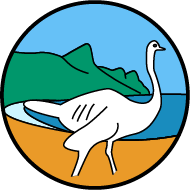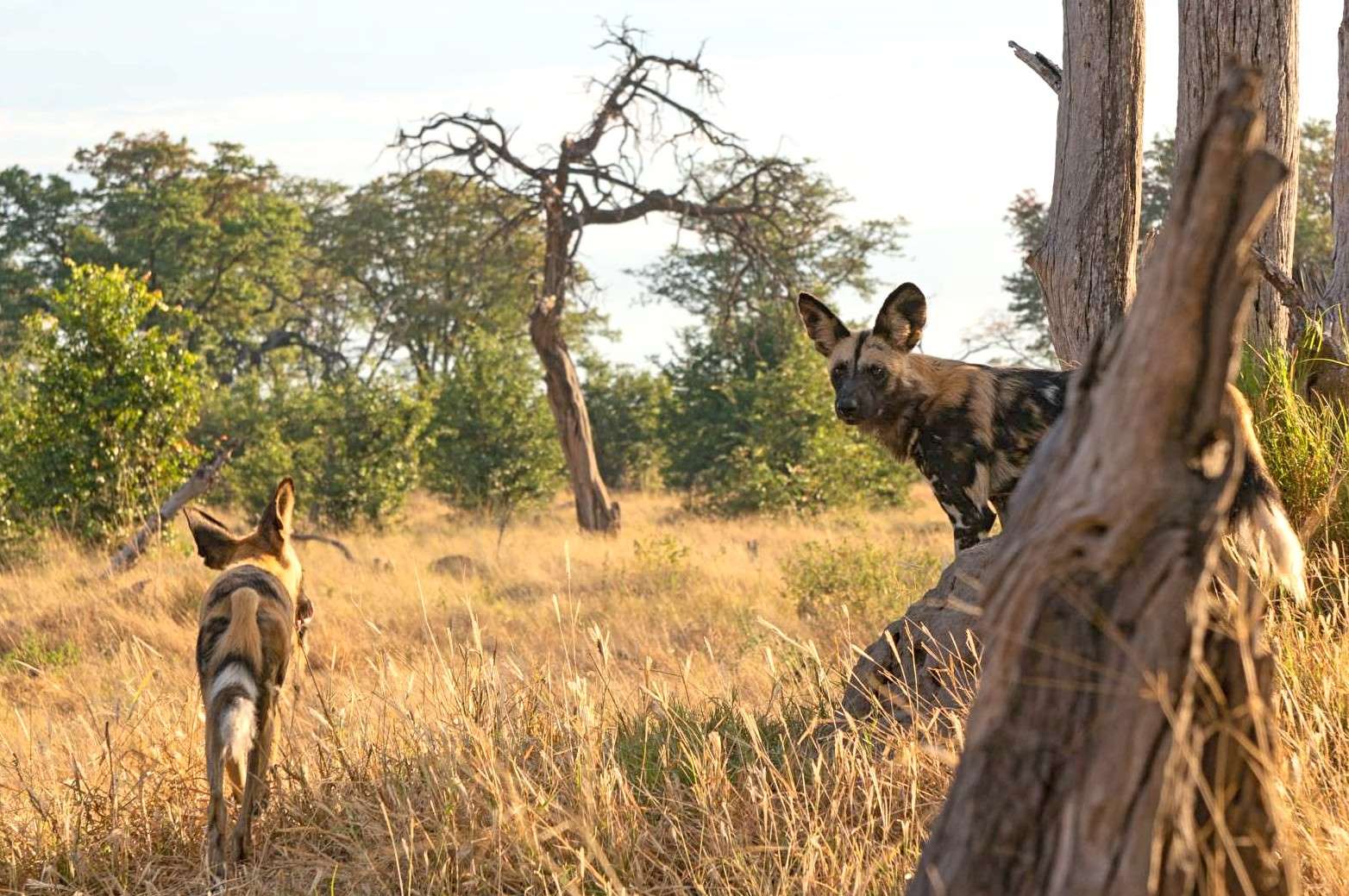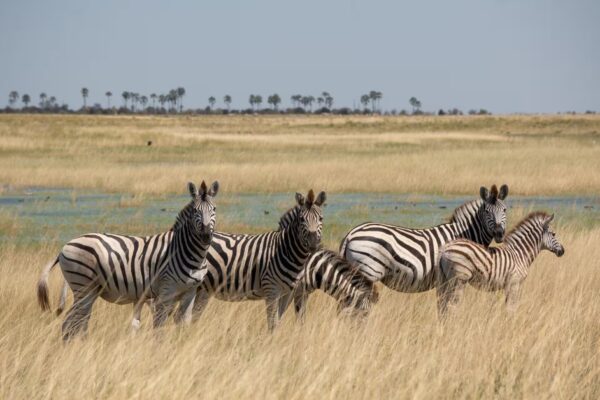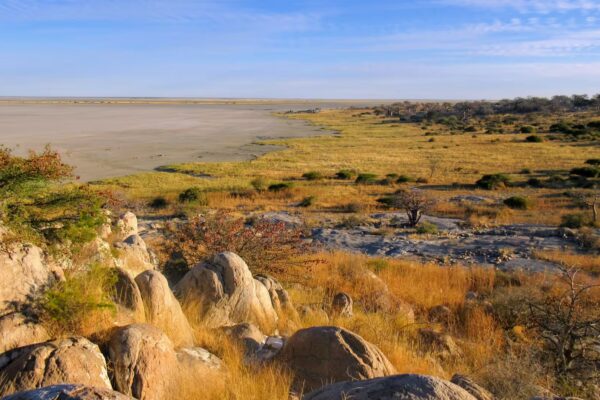By Vicky · Published Aug. 8th, 2022 · Updated Dec. 10th, 2022
When you buy through links highlighted with an asterisk (*) on this site, we may earn a small affiliate commission at no cost to you.
Khwai Community Concession is an amazing safari destination. Elephants wander through the campsites and high concentrations of game drink from the river. Plus, there’s a high chance of seeing big cats and wild dogs.
Page Contents:
Location
Khwai Community Concession is sandwiched between Moremi and Savuti (Chobe) National Parks on the edge of the Okavango Delta in northern Botswana. Khwai is 125 km north of Maun on the most direct route. It’s 150 km from Maun via the Mababe route, which avoids having to pay park fees to transit through Moremi.
Khwai Community Map
Tips for Khwai
- It’s easier to get a campsite in Khwai than in Moremi, but it’s still always better to book in advance.
- The Tracks4Africa Botswana Map* is very useful.
- Fuel up and get groceries at Maun to the south or Kasane in the north beforehand. There’s no fuel and only soft drinks are guaranteed to be found in Khwai.
- You can rent an equipped 4×4* from nearby Maun or Kasane.
- Check out our guide to nearby Moremi Game Reserve, Maun or Savuti.
- Find the best books to read while in Botswana.
- We stopped at Khwai in the middle of our two-month Botswanan road trip which you can read more about in my book*.
The Khwai Development Trust manages the Khwai Community Concession, an area of about 2,000 km² reserved for wildlife tourism and conservation. Outside of the small Khwai Village, it’s a true wilderness with high concentrations of game. It’s definitely worth stopping here for a couple of nights if you’re travelling between Chobe and Moremi – wild dog and lion sightings are relatively common. You can read more about our time in this park in the travel adventure book I wrote, No Footprints in the Night: On Safari in Botswana*.
Khwai is composed of rivers, lagoons, and open grassy plains along with sections of woodland. Most of the area is open to the public and you can drive anywhere, while Khwai Private Reserve is only accessible to those staying at the luxury lodges within.
Information and Itinerary
There is no fuel or facilities in Khwai Community Concession apart from a very basic shop in Khwai Village. Stock up everything you need beforehand, either in Maun to the south (125 km on the most direct route), or Kasane to the northeast (270 sandy kilometres straight through Savuti). If you haven’t paid for your camping already, make sure to bring cash.
Gate Opening Hours
There are no gates in Khwai! It’s a community concession rather than a park managed by DWNP so there are no gate hours. However, officially you can only go on night drives when accompanied by a staff member from the Khwai Development Trust. The lodges in Khwai, unlike those in Moremi, do offer night drives.
Khwai Itinerary
Within Khwai Concession we camped for two nights at Magotho Campsite (also known as Khwai Community Camp). The night before we stayed at South Gate in Moremi, and after spending the morning in the National Park, we arrived at our campsite in Khwai around lunchtime.
After setting up our camp, went on a game drive that afternoon. The second day in Khwai, we went on game drives in the early morning and late afternoon. On our third and final day, we went on a short game drive in the morning and then set off towards Savuti in the north.
We could easily have stayed one or two nights more in Khwai. It was a really beautiful place, and the highlight was the peaceful elephants wandering through the campsite. One downside was that some of the tracks near the river were waterlogged, and others slightly further from the river were slightly overgrown. This made getting anywhere very slow going.
Best time of year to visit Khwai Community Concession
Similar to other places around Okavango Delta, the best time of year to visit Khwai is officially in the dry season between May and October. This is when game comes from far and wide to the water in the delta region, with the water in the bush all dried up. The concentration of antelopes and other grazers attracts predators and so your chances of seeing big cats and dogs is high. Dry season also means the tracks should be easy to drive.
In rainy season, November to April, some of the tracks near the river may be waterlogged, and the concentration of game may be less high. However, there’s always game around in Khwai no matter the season. We were there in April, when the bush still had quite a lot of water, yet saw lions and wild dogs, many elephants, hippos, and many antelope in Khwai. An advantage of rainy season is that there are often fewer tourists and many more birds.
Khwai Village
Khwai Village has a couple of small, poorly-stocked shops and a bar. There’s a convenience store that sells cold drinks, beer, sometimes bread and a few other basic items. If lucky, you might find vegetables. If you ask around, you might be able to find ice. However, the ice will be in large blocks (not ice cubes) and is made from the river water, so not good for drinking, only cooling.
The Khwai Development Trust Office is to the south of the village, on the west of the road a few hundred metres north of Moremi North Gate Entrance. They can give you information about the area and book campsites and activities, though it’s best to have campsites booked in advance. The Trust offers mokoro and motor boat trips, bush walks, night drives (your own car, accompanied by a guide) and cultural tours.
How to get to Khwai Community Concession
How to get to Khwai from Maun
There are two direct routes to drive from Maun to Khwai. Commonly, self-drivers spend a few nights in Moremi before or after visiting this area. If you’re driving straight between Maun and Khwai, the second option is slightly quicker and you don’t have to pay park fees. You still might encounter animals on the way.
- Maun to Khwai via Moremi
The first route heads through Moremi Game Reserve. It’s 125 km and takes about 3-4 hours. You have to pay park fees to drive this way, since you have to enter into the Game Reserve. If you choose this route, follow signs to Moremi South Gate, then just after the gate turn right and right again to follow the cutline north, straight through to Khwai.
- Maun to Khwai via Mababe
The second route heads towards Mababe village before turning left (west) towards Khwai. This route is 150 km and takes only about 3 hours since the roads are better than those through Moremi. You don’t have to pay park fees on this route.
How to get to Khwai from Kasane
Khwai is 250 km from Kasane, on a sandy route through Savuti. There is only really one route until south of Savuti where you have to decide whether to take the Sand Ridge Route or Marsh Route. Ask at Savuti Campsite for the best advice. In general, in the wet season the Sand Ridge Route is recommended, and in the dry season the Marsh Route is better. Whichever way you go, expect a lot of sand. It’s almost never a problem for those with a decent 4×4 who aren’t pulling. The people who tend to get stuck are those pulling heavy trailers without a good enough car.
Road Conditions in Khwai
The tracks in Khwai are decent away from the river, though near the water they are a bit of a mess. The tracks change with the seasons and years, with a myriad of little routes to choose from. Depending on the time of year, some will end in mud or water or an impenetrable bush. Others will continue nicely. Maps, no matter how detailed, are never too much help for the fine details because of the changing tracks, track conditions, and vegetation. The good news is, it’s not very sandy in most of Khwai.
We drove 110 km in total in Khwai Community Concession. This includes the drive from Moremi North Gate to our campsite, two morning and two afternoon drives (all not too far because of slow tracks and many animals), and the drive out of the area to Mababe Gate on the way to Savuti. We stopped off here on the long drive between Maun and Kasane, filling up fully our fuel tank and jerry cans in Maun.
Botswana Overlanding Book
I captured our many adventures in a travel book, check it out on Amazon*.
South Africa was kicking us out so we had to make a plan. ‘What about Botswana?’ A few days before we overstayed our visas, we hit the road in our trusty Defender and sped north from Cape Town.
Self-Drive Safaris in Khwai Concession
Within the area, the game concentrates around the river and nearby. Almost certainly you’ll see elephants, and they may well wander through your camp. There are a wide variety of antelopes and birds here, often also to be seen from your campsite.
Wild dogs are a relatively common sight, and we saw a large pack of them early one morning not far from the campsite. Lions are also found in the area, and we randomly came across a mum and cub sitting in vegetation next to a track by the river. Hyenas are common in some locations, and it’s sometimes known where hyena and wild dog dens are. You’ll be luckier to see leopards, and even luckier to see an elusive cheetah. Ask around at your campsite for any sightings tips.
Khwai Entrance Fee and Camping Rates
There are no entrance fees to Khwai since it’s a community concession. Camping rates are around P350 per person per night everywhere in Khwai concession, and there’s often no difference between international and SADC rates.
Contact details for the different campsites are given below, but we ended up booking all our campsites in Botswana via Botswana Footprints. There were very professional and their booking fee was surprisingly low.
Magotho Camping: Managed by Khwai Development Trust. Email [email protected]. Phone: (+267) 680 1211, or (+267) 686 2365.
Mbudi Camping: Contact [email protected], +267 686 0614, +267 72 591 337 or +267 73505 576.
Khwai Safari Grounds: Contact [email protected], +267 73 681 757.
Campsites near Mababe, east of Khwai: Contact the Mababe Community Camps: [email protected], +267 680 0010, +675 7312 9016 or visit the Mababe Tsokotsama Community Trust Office in Maun.
Campsites in Khwai Concession
Magotho, Mbudi and Khwai Safari Grounds Campsite are the most popular campsites within Khwai Concession, you can’t go wrong with any of these three sites. Magotho (aka Khwai Community Camp) is the longest established and largest, though still with a proper wilderness feel and good ablutions. Mbudi is smaller and doesn’t have that many tracks immediately by the campsite, though still plenty of game can be seen from the campground. Khwai Safari Grounds Campsite is fairly new and similar to Magotho.
The campsite called Matswere (often wrongly placed on maps) and Sable Alley Campsite are not open to the public, these are only for registered Botswana tour companies.
Magotho Campsite
Magotho Camp (map↑), also known as Khwai Community Camp, is about 20 km east of Khwai Village. It’s a large, spread-out campsite and known for the many elephants that wander through. The camp is managed by the Khwai Community Trust and now has two nice ablution facilities (though these can be slightly far from some campsites). All sites have a concrete braai pit.
Magotho Campsite is well-signed from the main road, 20 km east along a good dirt road from the village. It’s then a few kilometres along slightly sandy tracks to the camp. The campsite is divided into two areas of campsites. One area overlooks the river and can be slightly more crowded (sites 9 to 15). The other area is further from the river, below huge trees, with larger, more spread-out campsites (sites 1 to 8). This section is less crowded because it’s not immediately next to the river.
Elephants often trundle through Magotho Campground. Our campsite seemed to be in the direct line of elephants crossing the river. Initially we were slightly scared, but once we realised the elephants were all calm, gentle males (single or in small groups), we became more confident. We even stood on a log and faced them down to stop them from walking through our camp while we were cooking dinner. They stopped 10 metres from us and decided to take the slightly longer way around.
Magotho Campsite Details
Magotho Camping is managed by Khwai Development Trust. Email [email protected]. Phone: (+267) 680 1211, or (+267) 686 2365. Magotho Camp is also called Khwai Community Camp. Representatives will come round in the late afternoon to check your booking and make sure everything is fine. Alternatively, you can pop into the Khwai Development Trust office just south of Khwai Village to check in.
It’s P350 per person per night and half-price for under 12s at Magotho Campsite. There’s no difference in price for SADC versus international visitors. You should arrive at your site after 11am, and depart before 11am on the day you leave.
Campsites
The numbering of campsites in Magotho is very confusing, with the sites all having been renumbered/moved multiple times. Some sites have two numbers (the old, and the new numbers), while some sites don’t have any numbers at all but you can still camp there. Magotho is also notorious for sites being double booked (the confusing numbering system probably doesn’t help). It often occurs that people turn up and their site is already taken. In which case, the campsite wardens tell you to choose from any other site.
We stayed in Magotho 4, right by the river. It was a great site as it was close to the water with fantastic views, elephants wandered right by, it was a dead-end so we had no other traffic, and it wasn’t too far from the ablutions. However, it wasn’t the largest site so more than two vehicles would struggle to fit in.
Khwai Safari Grounds Campsite
Khwai Safari Grounds (map↑) is a great alternative to Magotho. A lot of game can be seen near (and in) camp, including elephants and hippos. It has hot showers (with slightly low water pressure), flush toilets, and wood is available to buy at the reception. The sites are fairly large, private, and well spaced out. Most sites also have good views of the water. Two sites are reserved for mobile safari groups, and these can get slightly busy.
Khwai Safari Grounds Details: To reserve, contact [email protected], +267 73 681 757. Rates are P350 per person per night for all nationalities. The turnoff is well signed from the main road, 2.5km further east from Mbudi Campsite. It’s about 2 km along a slightly sandy track to the reception hut of the campsite. Mokoro excursions and guided walks are also available from the campsite.
Mbudi Campsite
Mbudi Campsite (map↑) is a nice campsite by a small river, with animals wandering through. There are several campsites, all with shared ablutions with hot showers and flush toilets. Each site overlooks the water and is quite private. Firewood and clean water are sold at the reception. Mokoro trips can also be booked here.
Mbudi Campsite Details: To book Mbudi campsite, contact [email protected], +267 686 0614, +267 72 591 337 or +267 73505 576. It’s P350 per person per night. The campsite is well-signed from the main road.
Campsites Near Mababe River on the Eastern edge of Khwai
There are several campsites south of Mababe Village, though they seem to change often and management/cleanliness can be an issue. That said, they might be cheaper than in Khwai, less crowded and also have fantastic views with game wandering through the campsites. Mababe Village sells cold drinks, beer and firewood.
For more details and to book the Mababe Community Camps: [email protected], +267 680 0010, +675 7312 9016 or at the Mababe Community Trust Office in Maun.
The three sites that the Mababe Community manages are Dijara Campsite (perhaps not operational anymore), Tshaa Community Camp (aka Xanakgaei, site 6 is recommended for the views) and Dizhana Camp. These camps are all on the banks of the Khwai River with shared (or private) ablutions and fireplaces at each site. There are lots of hippos in this area – don’t wander around in the dark and don’t get between them and the water.
Luxury Safari Lodges in Khwai
Khwai Guest House is the cheapest non-camping option in Khwai by far, though it’s in the village and not the wilderness. Khwai Expeditions Camp is the second cheapest place – in the wilderness but not as luxurious as the other more expensive options.
Khwai Bush Camp (Website, Tripadvisor Reviews*): A lovely lodge on the Khwai River in dense game territory with many activities.
Khwai Expeditions Camp (Website, Tripadvisor Reviews*): Relatively good value camp in Khwai with tented rooms overlooking a seasonal lagoon.
Khwai Guest House (Website, Tripadvisor Reviews*): Very affordable guesthouse with basic bungalows and a small pool, 2km outside Moremi North Gate near Khwai Village. No views from the rooms and not in a wilderness setting. Can organise activities and has very friendly staff. A good base for self-drivers not wanting to camp.
Khwai Leadwood (Website, Tripadvisor Reviews*): A beautiful camp on the banks of the Khwai River, an intimate camp. Game drives, night drives, walking safaris, mokoro trips.
Khwai River Lodge (Website, Tripadvisor Reviews*): On the banks of the Khwai River, all accommodation has its own private deck overlooking the water. Game drives, walking safaris, bird-watching, star gazing on offer.
Machaba Camp (Website, Tripadvisor Reviews*): A luxury lodge on the banks of the Khwai River. Game drives, night safaris, walking safaris, mokoro trips.
Magothlo Safari Lodge (Website, Tripadvisor Reviews*): near Mababe. Game drives, bush walks, cultural activities, night drives, bush dinners. Tented accommodation on the banks of the Khwai River. en-suite, facing the river with a viewing deck.
Nokanyana Lodge (Website, Tripadvisor Reviews*): Also on the relatively affordable side, on the banks of the Khwai River near Mababe.
O Bona Moremi Safari Lodge (Website, Tripadvisor Reviews*): Overlooking a tributary of the River Khwai with great facilities and wildlife sightings.
Sable Alley (Website, Tripadvisor Reviews*): A luxury lodge in Khwai Private Reserve. Dense wildlife on the banks of a lagoon full of hippos. Game drives, night drives, mokoro excursions, bush walks.
Saguni Safari Lodge (Website, Tripadvisor Reviews*): Lodge overlooking Mbudi Lagoon with spacious tents. Game drives, night drives, bush walk, mokoro trips and cultural visits. Relatively affordable compared to more luxurious lodges.
Sango Safari Camp (Website, Tripadvisor Reviews*): Lodge overlooking the Khwai River with game drives, night drives, mokoro trips and village tours.
I hope you enjoyed our guide to Khwai Community Concession in Botswana. If so, check out nearby Moremi Game Reserve or Savuti, or our overall Guide to Botswana.
The Lonely Planet Guidebook* covers all of Botswana, but not in much detail. The Bradt Guide* has a wealth of information and is great for planning a safari around northern Botswana, but doesn’t cover southern Botswana. The Tracks4Africa Map* is an essential item for driving around the country and its national parks. For more information, see our Best Botswana Guidebooks article.
Khwai Community Concession was a stop in Botswana on our two-month road trip. Find out more by reading the travel book I wrote, No Footprints in the Night: On Safari in Botswana*.
FAQS
The speed limit is 40 km/h.
Khwai is 125 km north of Maun on the most direct route. It’s 150 km from Maun via the Mababe route, which avoids having to pay park fees to transit through Moremi.
Magotho means Camel-Thorn, a type of big acacia that is common in the area.
Khwai is sandwiched between Moremi and Savuti (Chobe) National Parks on the edge of the Okavango Delta in northern Botswana.
During dry season (May-Oct) the concentration of game is highest and the tracks are mainly dry. However, there are still plenty of animals in the wet season (Nov-Apr), and some of the tracks never get too wet. Wet season is also a great time for birds and fewer tourists.








